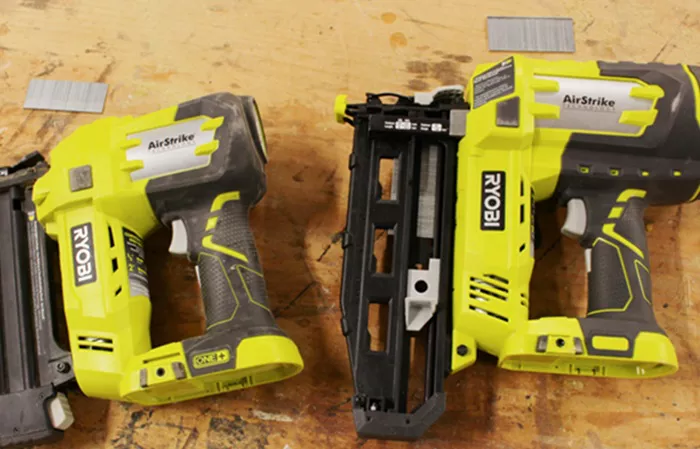A brad nailer is a specialized tool used in woodworking and carpentry. Unlike traditional nails or screws, which require manual driving and often leave large holes or splits, a brad nailer uses pneumatic or electric power to drive small, thin nails called brads into wood or other materials. This tool is valued for its precision, speed, and minimal impact on the material being worked on. Here’s everything you need to know about brad nailers:
Introduction to Brad Nailers
Definition and Purpose
A brad nailer is a type of nail gun designed to drive brad nails into wood or other materials. Brad nails are small, thin nails, typically ranging from 18 to 23 gauge in thickness and 1/2 to 2-1/2 inches in length. The primary purpose of a brad nailer is to attach trim, moldings, and other delicate woodwork with minimal damage and without the need for putty or extensive finishing.
Types of Brad Nailers
Brad nailers come in two main types: pneumatic and cordless (electric).
Pneumatic Brad Nailers: These are powered by compressed air from a compressor. They are typically more powerful and provide consistent performance but require a connected air compressor.
Cordless Brad Nailers: These are powered by rechargeable batteries or electricity. They offer greater mobility and convenience but may have slightly less power compared to pneumatic models.
How Does a Brad Nailer Work
Mechanism
A brad nailer operates by using either air pressure (pneumatic models) or battery power (cordless models) to drive a brad nail into the material. The user pulls a trigger to release the nail, which is driven into the material by a piston mechanism. Some brad nailers come with adjustable depth settings, allowing users to control how deeply the nail is driven.
Features and Components
Magazine: Holds the brad nails and feeds them into the firing mechanism.
Trigger: Activates the firing mechanism.
Depth Adjustment: Allows the user to control how deeply the nail is driven.
Safety Mechanism: Prevents accidental firing by requiring contact with the work surface before firing.
See also: How To Get Stripped Screw Out?
Benefits of Using a Brad Nailer
Precision and Clean Finish
Brad nailers are designed to deliver nails with precision, reducing the risk of splitting the wood or leaving visible holes. This makes them ideal for delicate trim work where a clean finish is essential.
Speed and Efficiency
Using a brad nailer speeds up the nailing process compared to manual methods. The tool can quickly drive multiple nails, which is especially useful for large projects or when working with intricate designs.
Minimal Surface Damage
Due to the small size of brad nails, the tool leaves minimal marks on the surface. This is advantageous for projects where aesthetics are crucial, such as when attaching molding or decorative elements.
Applications of Brad Nailers
Trim and Molding Installation
Brad nailers are commonly used to install trim, baseboards, and crown molding. The small nails do not require pre-drilling and are less likely to split the wood, making them ideal for these applications.
Craft and DIY Projects
For craft and DIY enthusiasts, brad nailers are perfect for assembling small projects or repairing furniture. Their ease of use and precision make them a popular choice for hobbyists.
Cabinetry and Furniture Assembly
In cabinetry and furniture making, brad nailers provide a quick and efficient way to attach parts without visible fasteners. They are especially useful for securing thin pieces of wood or decorative elements.
See also: How To Use A Whetstone: A Comprehensive Guide
Choosing the Right Brad Nailer
Gauge and Nail Length
The gauge of the brad nailer determines the thickness of the nails it can use. Common gauges are 18 and 23. A larger gauge (lower number) means thicker nails. The length of the nails also varies, so choose a brad nailer that accommodates the sizes you need for your projects.
Power Source
Decide between a pneumatic brad nailer, which requires an air compressor, and a cordless brad nailer, which operates on batteries. Pneumatic models are generally more powerful, while cordless models offer greater portability.
Additional Features
Look for features like adjustable depth control, a tool-free jam release, and a comfortable grip. These features enhance the usability and efficiency of the brad nailer.
Maintenance and Safety
Regular Maintenance
To ensure the longevity of your brad nailer, perform regular maintenance such as cleaning the tool, lubricating moving parts, and checking for wear and tear. Follow the manufacturer’s recommendations for maintenance.
Safety Tips
Always wear safety glasses and hearing protection when using a brad nailer.
Keep hands and fingers away from the firing area.
Ensure that the tool is properly maintained and free from obstructions.
Common Issues and Troubleshooting
Jamming
Brad nailers can occasionally jam. Most tools come with a tool-free jam release feature. Regularly check and clean the magazine and firing mechanism to prevent jams.
Inconsistent Firing
If the brad nailer does not fire consistently, check the power source (for cordless models) or air pressure (for pneumatic models). Also, ensure that the nails are properly aligned in the magazine.
Depth Adjustment Problems
If the nails are not driving to the correct depth, adjust the depth control settings. If problems persist, the tool may need servicing or repair.
Conclusion
A brad nailer is a versatile and efficient tool for woodworking, cabinetry, and various DIY projects. Understanding its functionality, benefits, and maintenance requirements will help you make the most of this valuable tool. Whether you choose a pneumatic or cordless model, a brad nailer can significantly improve the quality and speed of your work, making it an essential addition to any workshop or tool kit.
Related Topics:
-
In-Depth Evaluation Of Hart Tools: What To Expect From This Brand
-
Ryobi Drill In Review: An Expert Evaluation Of Features And Performance
-
Milwaukee M12 Review: Examining Build Quality, Battery Life, And Versatility

